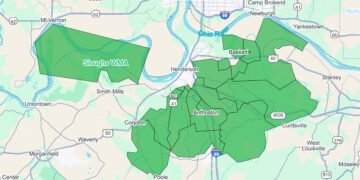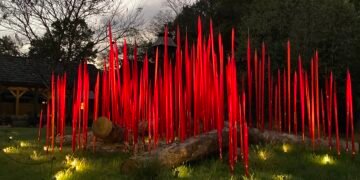It’s insect pest season in Kentucky
Summer is near and with it comes insects, particularly, stinging insects. In Kentucky, we have several insect pests that can pose problems with enjoying our patio or outside activities. In past years, I have received calls about a large, striped bee hovering above home lawns and many people have asked if this is the start to a ‘killer bee’ invasion or something worse. Fortunately, unless you are a cicada, you have nothing to fear. This intimidating insect is the Cicada Killer Wasp. The Cicada Killers rarely sting unless disturbed, but because of their large size (2 inches) people become concerned. These solitary wasps can also become a nuisance when they dig holes in lawns and flowerbeds kicking out a horse-shoe shaped mound of dirt. This year there are two broods of cicada’s hatching and likely we should expect to see an increased number of cicada killers.
Cicada Killers are similar in coloration of European hornets except their abdomen is black with light markings. They use their stingers to paralyze cicadas, which are used as food to rear their young. You may notice many individuals flying over a lawn, but each female digs separate burrows six to ten inches deep and one-half inch wide. Cicada Killers are present for only a few weeks and control is usually not warranted, however occasionally as many as 50 wasps may be present in a lawn. If avoidance is not practical, individual nests may be treated after dark with carbaryl (Sevin) dusts or pyrethrin aerosol sprays. Cover the hole with soil and tamp it down after treating. If the entire lawn is involved (10 to 20 burrows), a spray with the same insecticides is an alternative. Repeat treatments may be necessary.
European hornets are large (1 to 1 ½ inch) and very aggressive. They are distinguished by their reddish-brown heads and reddish-brown with yellow marked abdomens. The hornet’s nest can be found in hollow trees, attics, wall cavities or, if built in an un-protective site outdoors, it will be covered with a thick, brown envelope made of coarse, decayed wood fibers. These nests can become the size of a basketball. Consider sealing holes in structures (i.e., openings around wires, plumbing or conduit) to prevent European hornets from using your home as a nesting site. Nests should be located and treated to provide long-term control. European hornets are active day and night; therefore nest treatment is most successful just before sunrise when temperatures are cooler. Wear a bee suit and veil (or other protective clothing) and apply wasp and hornet aerosols into the nest opening. Nests in a home’s wall may require the help of a professional.
Yellowjacket wasps are great beneficial insects that feed on crop pests, but they are often considered the most dangerous stinging insects in the United States. The ground-dwelling yellowjackets have yellow and black markings and build nests underground in old rodent burrows or beneath rocks or landscape timbers. They live in colonies that by late summer can contain 4,000 workers. These wasps are very unpredictable and their nests should be either avoided or, if necessary, eliminated with great care. Yellowjackets are attracted to practically every dish at a picnic but are especially fond of sweets. You can reduce the threat of stings when eating outdoors by minimizing food sources, cleaning up spills promptly and keeping trash cans away from picnic areas and emptying them frequently. In a home lawn setting, elimination of yellowjackets is best accomplished by locating and destroying the nests. Look for the nests during the day and mark the entrance. Treatment should be performed at night when temperatures are cooler and most of the colony is in the nest. An aerosol-type wasp and hornet spray can be sprayed into the opening or you can use dust formulations Sevin puffed into the nest with a commercial duster for insecticide control.
Every insect has a purpose in the ecologic structure but often, we also need to take some precautions to protect ourselves or plants.
If you have questions about stinging insects this summer, give us a call at the Henderson County Extension Office. We are happy to help!



















